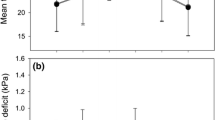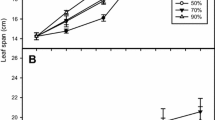Abstract
To understand dynamic photosynthetic characteristics in response to fluctuating light under a high CO2 environment, we examined photosynthetic induction in two poplar genotypes from two species, Populus koreana × trichocarpa cv. Peace and Populus euramericana cv. I-55, respectively. Stomata of cv. Peace barely respond to changes in photosynthetic photon flux density (PFD), whereas those of cv. I-55 show a normal response to variations in PFD at ambient CO2. The plants were grown under three CO2 regimes (380, 700, and 1,020 μmol CO2 mol−1 in air) for approximately 2 months. CO2 gas exchange was measured in situ in the three CO2 regimes under a sudden PFD increase from 20 to 800 μmol m−2 s−1. In both genotypes, plants grown under higher CO2 conditions had a higher photosynthetic induction state, shorter induction time, and reduced induction limitation to photosynthetic carbon gain. Plants of cv. I-55 showed a much larger increase in induction state and decrease in induction time under high CO2 regimes than did plants of cv. Peace. These showed that, throughout the whole induction process, genotype cv. I-55 had a much smaller reduction of leaf carbon gain under the two high CO2 regimes than under the ambient CO2 regime, while the high CO2 effect was smaller in genotype cv. Peace. The results suggest that a high CO2 environment can reduce both biochemical and stomatal limitations of leaf carbon gain during the photosynthetic induction process, and that a rapid stomatal response can further enhance the high CO2 effect.





Similar content being viewed by others
References
Ainsworth EA, Long SP (2005) What have we learned from 15 years of free-air CO2 enrichment (FACE)? A meta-analytic review of the responses of photosynthesis, canopy properties and plant production to rising CO2. New Phytol 165:351–372
Ainsworth EA, Rogers A (2007) The response of photosynthesis and stomatal conductance to rising [CO2]: mechanisms and environmental interactions. Plant Cell Environ 30:258–270
Allen MT, Pearcy RW (2000a) Stomatal behavior and photosynthetic performance under dynamic light regimes in a seasonally dry tropical rain forest. Oecologia 122:470–478
Allen MT, Pearcy RW (2000b) Stomatal versus biochemical limitations to dynamic photosynthetic performance in four tropical rain forest shrub species. Oecologia 122:479–486
Buchmann N, Guehl JM, Barigah TS, Ehleringer JR (1997) Interseasonal comparison of CO2 concentrations, isotopic composition, and carbon dynamics in an Amazonian rainforest (French Guiana). Oecologia 110:120–131
Ceulemans R, Mousseau M (1994) Tansley review No.71. Effects of elevated atmospheric CO2 on woody-plants. New Phytol 127:425–446
Chazdon RL (1988) Sunflecks and their importance to forest understory plants. Adv Ecol Res 18:1–63
Chazdon RL, Pearcy RW (1986) Photosynthetic responses to light variation in rainforest species. I. Induction under constant and fluctuating light conditions. Oecologia 69:517–523
Farquhar GD, von Caemmerer S, Berry JA (1980) A biochemical model of photosynthetic CO2 assimilation in leaves of C3 plants. Planta 149:78–90
Holtum JAM, Winter K (2001) Are plants growing close to the floors of tropical forests exposed to elevated concentrations of carbon dioxide? Aust J Bot 49:629–636
IPCC (Intergovernmental Panel on Climate Change) (2007) Climate change 2007: The physical science basis. Contribution of working group I to the Fourth Assessment Report of the Intergovernmental Panel on Climate Change. Cambridge, Cambridge University Press, UK
Kirschbaum MUF, Pearcy RW (1988) Gas exchange analysis of the relative importance of stomatal and biochemical factors in photosynthetic induction in Alocasia macrorrhiza. Plant Physiol 86:782–785
Knapp AK, Smith WK (1990) Stomatal and photosynthetic responses to variable sunlight. Plant Physiol 78:160–165
Knapp AK, Fahnestock JT, Owensby CE (1994) Elevated atmospheric CO2 alters responses to variable sunlight in a C-4 grass. Plant Cell Environ 17:189–195
Košvancová M, Urban O, Šprtová M, Hrstka M, Kalina J, Tomášková I, Špunda V, Marek MV (2009) Photosynthetic induction in broadleaved Fagus sylvatica and coniferous Picea abies cultivated under ambient and elevated CO2 concentrations. Plant Sci 177:123–130
Leakey ADB, Press MC, Scholes JD, Watling JR (2002) Relative enhancement of photosynthesis and growth at elevated CO2 is greater under sunflecks than uniform irradiance in a tropical rain forest tree seedling. Plant Cell Environ 25:1701–1714
Leakey ADB, Scholes JD, Press MC (2005) Physiological and ecological significance of sunflecks for dipterocarp seedlings. J Exp Bot 56:469–482
Naumburg E, Ellsworth DS (2000) Photosynthetic sunfleck utilization potential of understory saplings growing under elevated CO2 in FACE. Oecologia 122:163–174
Naumburg E, Ellsworth D, Katul GG (2001) Modeling daily understory photosynthesis of species with differing photosynthetic light dynamics in ambient and elevated CO2. Oecologia 126:487–499
Niinemets U (2007) Photosynthesis and resource distribution through plant canopies. Plant Cell Environ 30:1052–1071
Parry MAJ, Keys AJ, Madgwick PJ, Carmo-Silva AE, Andralojc PJ (2008) Rubisco regulation: a role for inhibitors. J Exp Bot 59:1569–1580
Pearcy RW (1990) Sunflecks and photosynthesis in plant canopies. Annu Rev Plant Physiol Plant Mol Biol 41:421–453
Pearcy RW (2007) Responses of plants to heterogeneous light environments. In: Pugnaire FI, Valladares F (eds) Functional plant ecology. CRC Press, New York, pp 213–246
Pearcy RW, Osteryoung K, Calkin HW (1985) Photosynthetic responses to dynamic light environments by Hawaiian trees. Plant Physiol 79:896–902
Pearcy RW, Chazdon RL, Gross LJ, Mott KA (1994) Photosynthetic utilization of sunflecks: a temporally patchy resource on a time scale of seconds to minutes. In: Caldwell MM, Pearcy RW (eds) Exploitation of environmental heterogeneity by plants. Academic, San Diego, pp 175–208
Pearcy RW, Krall JP, Sassenrath-Cole GF (1996) Photosynthesis in fluctuating light environments. In: Barber NR (ed) Photosynthesis and the environment. Kluwer, Dordrecht, pp 321–346
Sassenrath-Cole GF, Pearcy RW (1992) Regulation of photosynthetic induction state by magnitude and duration of low light exposure. Plant Physiol 105:1115–1123
Tang YH (1997) Natural, abiotic factors—light. In: Prasad MNV (ed) Plant ecophysiology. Wiley, New York, pp 3–40
Tang YH, Liang NS (2000) Characterization of the photosynthetic induction response in a Populus species with stomata barely responding to light changes. Tree Physiol 20:969–976
Tang YH, Washitani I, Tsuchiya T, Iwaki H (1988) Fluctuation of photosynthetic photon flux density within a Miscanthus sinensis canopy. Ecol Res 3:253–266
Tinoco-Ojanguren C, Pearcy RW (1993) Stomatal dynamics and its importance to carbon gain in 2 rain-forest piper species. 2. Stomatal versus biochemical limitations during photosynthetic induction. Oecologia 94:395–402
Urban O (2003) Physiological impacts of elevated CO2 concentration ranging from molecular to whole plant responses. Photosynthetica 41:9–20
Urban O, Šprtová M, Košvancová M, Toma′ šková I, Lichtenthaler HK, Marek MV (2008) Comparison of photosynthetic induction and transient limitations during the induction phase in young and mature leaves from three poplar clones. Tree Physiol 28:1189–1197
Valladares F, Allen MT, Pearcy RW (1997) Photosynthetic responses to dynamic light under field conditions in six tropical rainforest shrubs occurring along a light gradient. Oecologia 111:505–514
von Caemmerer S, Farquhar GD (1981) Some relationships between the biochemistry of photosynthesis and the gas exchange of leaves. Planta 153:376–387
von Caemmerer S, Quick WP (2000) Rubisco: physiology in vivo. In: Leegood RC, Sharkey TD, von Caemmerer S (eds) Photosynthesis: physiology and metabolism. Kluwer, Dordrecht, pp 85–113
Woodrow IE, Mott KA (1989) Rate limitation of non-steady-state photosynthesis by ribulose-1,5-bisphosphate carboxylase in spinach. Aust J Plant Physiol 16:487–500
Acknowledgments
This study was supported by a Grant-in-Aid for Scientific Research on Innovative Areas “Comprehensive studies of plant responses to high CO2 world by an innovative consortium of ecologists and molecular biologists” [No. (22114513)]. We thank Robert W. Pearcy and two reviewers for their constructive comments and suggestions. We also thank Ichiro Terashima and Kouki Hikosaka for their encouragements and discussion during the study.
Author information
Authors and Affiliations
Corresponding author
Additional information
Communicated by Robert Pearcy.
Rights and permissions
About this article
Cite this article
Tomimatsu, H., Tang, Y. Elevated CO2 differentially affects photosynthetic induction response in two Populus species with different stomatal behavior. Oecologia 169, 869–878 (2012). https://doi.org/10.1007/s00442-012-2256-5
Received:
Accepted:
Published:
Issue Date:
DOI: https://doi.org/10.1007/s00442-012-2256-5




